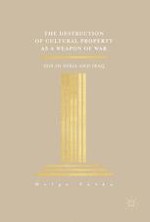2018 | OriginalPaper | Buchkapitel
6. Future Action to Protect Cultural Property During Conflict
verfasst von : Helga Turku
Erschienen in: The Destruction of Cultural Property as a Weapon of War
Aktivieren Sie unsere intelligente Suche, um passende Fachinhalte oder Patente zu finden.
Wählen Sie Textabschnitte aus um mit Künstlicher Intelligenz passenden Patente zu finden. powered by
Markieren Sie Textabschnitte, um KI-gestützt weitere passende Inhalte zu finden. powered by
